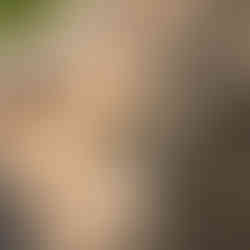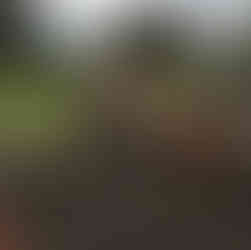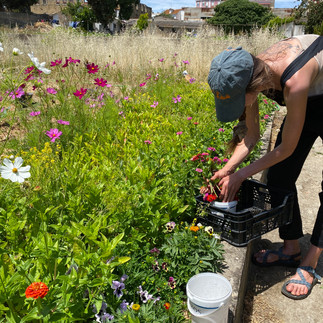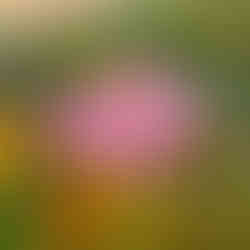A Garden to Dye For
- annettebrinckerhof
- Aug 4, 2021
- 3 min read
I came to natural dyeing through a love for plants. I love growing plants, collecting plants, working with plants, and being around plants. So it was only natural that one of my main goals for Tinctorium Studio was establishing a dye garden.

I won't lie, it has been a difficult endeavour - full of complications, learning curves, plot twists, and logistical challenges. I'm extremely proud of what I've been able to accomplish given the many constraints and lack of budget. Mostly I'm enormously grateful to all the people that have contributed time, seeds, money, and expertise on this dream.
Together we have been able to transform a part of this under-utilised land completely taken over by weeds into a dye garden, bursting with flowers.
This opportunity came about like many do, through a chance encounter. While working a market at Arroz Studios, I learned about a community garden project happening near my studio. I scheduled a visit and was immediately enchanted by this hidden garden - a wild area completely hidden from the street.
The land belonged to the municipality but had been ceded for public use through an open call for project proposals. The winning project came on behalf of Cozinha Popular da Mouraria, a kitchen-based social intervention organization which sustains itself by organising community dinners.

Their vision was to turn the land into an edible garden that would directly supply an on-site, open-air kitchen. Due to a series of unfortunate events, the kitchen project was put on pause and from one day to the next my allotted growing space multiplied in size!

More growing space is awesome, but I was definitely not prepared to handle it on my own. So, I put a call for volunteers on Instagram and who shows up? My fellow natural dyer and friend, Tamara from Distinto Studio, followed by her wonderful group of friends. Real heroes don't always wear capes.
Thanks to these ladies, we were able to prepare new beds and get more flowers in the ground in the middle of June. Better late than never.
Not everything was done as efficiently as possible, but I learned so much for next year!
Having a dye garden is extremely important to me, especially as a dyer who works primarily with locally sourced dye materials. Portugal is bursting with natural color but it's not always easy to find reliable sources of bright colors. It can be frustrated to be limited to working with yellows, browns, olive greens, etc. It is also rather stressful and time consuming to carefully 'clean up' the broken flowers from public parks.

Having a dye garden means having a rainbow of color at my disposal and allows me to localize my practice even more, achieve a greater diversity of colors without importing extracts, and dye with plant parts that don't store and ship easily. Even more than that, I think it's essential to growing my relationship with the plants I work with. In natural dyeing there are so many variables which influence the final outcome that growing your own plants is the only way to appreciate differences season after season.

The harvests from the garden have been so bountiful, that I can't possibly use all the material in my practice. So I'm thrilled to offer Field to Fabric bundle dye kits packed with marigolds, cosmos, violas, and coreopsis from my garden.
From my garden to your closet, the Field to Fabric bundle dye kits are now available to pre-order on the webshop. The kit includes aluminum mordant to pre-treat fabrics, flowers to bundle dye with, iron sulfate to modify colors, and detailed instructions that take you through the full process to dye a tote or to upcycle your clothes.
For anyone wishing to visit or volunteer at the garden, please send me a message so I can add you to the group chat. Open garden days tend to be on Mondays and Thursdays, but some alterations to the schedule can occur. We're also always open to seed, soil, compost, pots, and other garden tool donations!

For those interested, here's a full list of dye plants I'm growing (*or tried to grow):

Woad (Isatis tinctoria)
Japanese indigo (Persicaria tinctoria)
Coreopsis (Coreopsis tinctoria + dwarf variety)
Madder
Lady's Bedstraw (Galium velum)
Weld (Reseda luteola)
Violas
Many varieties of marigolds (Tagates)
Calendulas
Cosmos (Cosmos sulfureis and bipinnatus)
Black Eyed Susans
Pincushion flower (Red and black scabiosa)
Syrian rue* (Peganum Harmala)
Forking Larkspur (Consolida regalis)
Delphinium (Delphinium grandiflorum)
Zinnias (Zinnia mexicana and a common variety)
Dalias (Dalia varabais)
Sweet wormwood (Artemesia annua)
Bachelors button (Centaurea azul)
Black hollyhock (Alcea Rosea Nigra)
Forget me not (myosotis)
St. Johns Wort* (Hypericum)
Equinacea
Lobelia* (Lobelia cascade)
Elder tree (sambucus nigrus)
Azalea
Sweet Willian (Dianthus barbatus)
Verbena
Cockscomb (Celosia)
Columbine*
Hopi Black Dye Sunflower (Tceqa' Qu' Si)
Please feel free to comment any other suggestions of dye plants you've grown or would recommend I grow!

















Comments